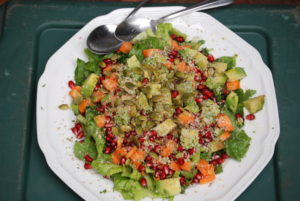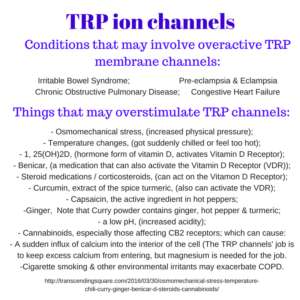1. Talk Therapy or “Just say no” can’t help a genetic difference.
-
Looking up the definition of the word “disease” suggests that a genetic difference affecting a body wide receptor system might fit the term “body disease.” “Disease: a disorder of structure or function in a human, animal, or plant, especially one that produces specific signs or symptoms or that affects a specific location and is not simply a direct result of physical injury.” – Oxford Dictionaries (I.1.disease)

-
Endogenous refers to something that can be made internally by our body rather than a chemical that is needed to be obtained from an external source on a daily or semi-regular basis. An example such as oxygen from the air we breathe is needed within every few minutes or cellular damage can start to occur; or trace nutrients such as essential fats or fat soluble vitamins may not be needed as often because they can be stored in the fat and membranes of the body. They may only need to be consumed in the diet every few days or weeks without resulting in negative health effects. The body can store extra vitamin D during summer months that can last most of the winter but does start to run out by springtime.
-
Cannabinoids are a type of chemical called phospholipids which are formed from a lipid, a type of fat, and the mineral phosphorus.
-
Food Sources of Phospholipids and other phospho-nutrients: Hemp seed kernels and oil; Artemisia turanica/wormwood leaf; amaranth seed; asparagus; avocado fruit or the inner kernel, dried and powdered; beans/legumes; cardamom seeds and powder; carrots; celery stalks and leaves; cocoa beans and cocoa powder, baker’s chocolate, dark chocolate and to a lesser amount milk chocolate and chocolate syrup; coconut; cumin seed/powder; fennel seed, flax seed, pine nuts; sesame seeds, pumpkin seed kernels, squash seeds; butternut squash and pumpkin; gingko leaf; grapefruit and orange juice with the pulp; Jerusalem artichoke (this is a root vegetable rather than a green artichoke); lettuce, spinach and mustard leaves and other leafy green vegetables and herbs; nuts/peanuts, cashews, walnuts; oats; okra seeds; onion root, leek leaves, garlic; parsnip root; pomegranate seeds and pomegranate peel extract;rice, white or brown but the bran is the best source; rosemary; sorghum; sweet potato or yam; buckwheat (a seed botanically that is not wheat and is gluten free); wheat. (G.26)
2. It might be motivating to learn of an underlying cause to cravings.
-
-
Cannabinoids might help some types of eating disorders and some types of drug or alcohol addictions by providing an essential nutrient that the person might not be able to make.
-
-
If the body can’t make an important substance or convert substances into active forms then it becomes an essential nutrient – essential for that specific person’s daily diet.
3. Genetics of the cannabinoid system and binge eating disorder, alcohol abuse and drug addiction.
“It is important to note that, as with alcohol, marijuana, and heroin, a human genetic variant of the cannabinoid CB1 receptor gene CNR1 has been associated with susceptibility to cocaine and amphetamine dependence (Ballon et al. 2006, Comings et al. 1997; Zhang et al. 2004).”
-
Behavioral Neurobiology of the Endocannabinoid System; Ch.13: Drug Addiction, (page 334, I.9.Searchworks)
-
Rimonabant is not in use for drug addictions because it is associated with a significantly increased risk for suicide. This is an important point to note – blocking the endogenous cannabinoid system is associated with a significant risk for suicide.
-
-
For more information regarding binge eating disorder, drug addiction and rimonabant: See Ch.3: Endocannabinoid Receptor Genetics and Marijuana Use, (p72-73 & 91, I.10.Endo.pdf) and Ch.13: Behavioral Effects of Endocannabinoids, mentions that research with rimonabant has helped show excessive alcohol drinking behavior and development of alcoholism may be related to genetic differences in the CB1 receptors. (p319, I.10.Endo.pdf)
-
-
-
Impulse control deficits may involve the cannabinoid system: See Ch.13: Behavioral Effects of Endocannabinoids, (pp325-330, I.10.Endocannabinoids.Full Text.pdf).
-
-
Schizophrenia may be related to a deficiency in the cannabinoid receptors themselves rather than being due to a deficiency in cannabinoids: See Ch.15, Neuropsychiatry: Schizophrenia, Depression, and Anxiety,; of the book Endocannabinoids: The Brain and Body’s Marijuana and Beyond: (p378, I.10.Endocannabinoids.Full Text.pdf)
4. Sometimes people are wrong – Nixon was wrong.
“If the good people, in their wisdom, shall see fit to keep me in the background, I have been too familiar with disappointments to be very much chagrined.” – Abraham Lincoln (1809-1894), (p 634, I.23)
The person with a chronic need wants an herbal medicine that has a balanced variety of cannabinoids that treats a variety of symptoms, not just the euphoria inducing THC that can lead to overdose symptoms of a racing heart, feeling very chilled, and paranoia or anger combined with extra energy, so manic behavior might be a risk with an overdose reaction. Real lime or lemon juice products that are concentrated rather than being a watery lemonade may help counteract some of the mood changes associated with an overdose of THC. More on lemon oil is included in the next section.
5. Medical Marijuana helps reduce opioid use, which can save lives.
6. Resources for help or just someone to talk to:
-
-
National Helpline: Substance Abuse and Mental Health Services Administration: “SAMHSA’s National Helpline, 1-800-662-HELP (4357), (also known as the Treatment Referral Routing Service), is a free, confidential, 24/7, 365-day-a-year treatment referral and information service (in English and Spanish) for individuals and families facing mental and/or substance use disorders.” (1.30samhsa.org)
-
-
U.S. National Suicide Prevention Hotline: “Call 1-800-273-8255, Available 24 hours everyday.” (1.32.suicidepreventionlifeline.org)
Help is only helpful when you accept it. Recognizing that you need it is the first step.
Links and References:
(I’ll finish this list later, I’ve learned a lazy editing tactic is to skip the footnote numbers until the final draft is complete.)
- “Disease,” Oxford Dictionaries (I.1.disease)
- “BHMT,” wikigenes.org, http://www.wikigenes.org/e/gene/e/635.html (I.wikigenes.BHMT)
- Glycerophospholipid biosynthesis,
- metabolism ,
- Phospholipid metabolism,
- (I.6.genecards.BHMT) [http://www.genecards.org/cgi-bin/carddisp.pl?gene=BHMT] (I.6.genecards.BHMT)
- (I.7.genecards.phosphorylation) [http://pathcards.genecards.org/card/cdk-mediated_phosphorylation_and_removal_of_cdc6] (I.genecards.phosphorylation)
- “Leukotriene,” (I.8.scbt.com)
- Behavioral Neurobiology of the Endocannabinoid System; Ch.13: Drug Addiction, (page 334, I.9.Searchworks) Behavioral Neurobiology of the Endocannabinoid System, Editors David Kendall and Stephen Alexander (Springer, 2009, Nottingham, U.K.). (I.Searchworks)
- Endocannabinoids: The Brain and Body’s Marijuana and Beyond, (CRC Press, 2006, Boca Raton, FL), Chapter Three, Endocannabinoid Receptor Genetics and Marijuana Use, editor and chapter by Emmanuel S. Onaivi, et al., (pages 72-73, 91, and 333), Chapter 15, Neuropsychiatry: Schizophrenia, Depression, and Anxiety, chapter by Ester Fride and Ethan Russo, (page 378), (I.10.Endocannabinoids: FullText pdf)
- (I.11.sciencedaily) Genetic risk factor for binge eating discovered. Sciencedaily.com, Oct. 26, 2016, https://www.sciencedaily.com/releases/2016/10/161026170543.htm (I.sciencedaily)
- (I.12.ncbi.FragileX) Sabiha Abekhoukh and Barbara Bardoni, CYFIP family proteins between autism and intellectual disability: links with Fragile X syndrome, Front Cell Neurosci. 2014; 8: 81., ncbi.nlm.nih.gov https://www.ncbi.nlm.nih.gov/pmc/articles/PMC3973919/ (I.ncbi.FragileX)
- (I.13.reuters) Pathway Maps: G-protein signaling_RAC1 in cellular process, Life Sciences Research, thomsonreuters.com, http://lsresearch.thomsonreuters.com/maps/383 (I.reuters)
- (I.14.genecards.CYFIP2) CYFIP2, genecards.org, http://www.genecards.org/cgi-bin/carddisp.pl?gene=CYFIP2 (I.genecards.CYFIP2)
- (I.15.omicsgroup) Shahla Mohamadirizi1*, Vahid Shaygannejad2, Soheila Mohamadirizi3 and Marjan Mohamadirizi4, Eating disorders in a multiple sclerosis clinical population and its association with social anxiety. https://www.omicsgroup.org/journals/eating-disorders-in-a-multiple-sclerosis-clinical-population-and-its-associationwith-social-anxiety-2376-0389-1000183.php?aid=82623 (I.omicsgroup)
- (I.16.sphingolipids)
- (I17..mpcfaculty.lipids)
- (I.18.coconut) Handbook of Plant-Based Fermented Food and Beverage Technology, Second Edition, edited by Y. H. Hui, E. Özgül Evranuz CRC Press, May 17, 2012, https://books.google.com/books?id=5fvRBQAAQBAJ&pg=PA669&lpg=PA669&dq=sphingolipids+in+coconut&source=bl&ots=QlgC46XLn8&sig=Y5AiDM4oUTBp9BS3aOKCtWK0Fbk&hl=en&sa=X&ved=0ahUKEwiQuL-wmdbVAhUG7CYKHXZCCxsQ6AEILjAB#v=onepage&q=sphingolipids%20in%20coconut&f=false
- (I.19.BMHT.MS) Naveen Kumar Singhal, et al., Changes in Methionine Metabolism and Histone H3 Trimethylation Are Linked to Mitochondrial Defects in Multiple Sclerosis. J of Neuroscience Vol 35, Issue 45, 2015 PAGES: 15170-15186 ISSN: 0270-6474 https://www.researchgate.net/profile/Rohan_Dassanayake2/publication/283710653_Changes_in_Methionine_Metabolism_and_Histone_H3_Trimethylation_Are_Linked_to_Mitochondrial_Defects_in_Multiple_Sclerosis/links/5693c64508aeab58a9a2aaf3.pdf (I.BMHT.MS)
- (I.20.wikigenes)
- ( methionine )
- ( Dimethylglycine (DMG).
- John Bartlett, Familiar Quotations, 14th Ed., 1910, (p 634, I.23)
- (I.24.AMA resolution) American Medical Association Medical Student Section, Resolution 2, JUne 8, 2008, http://www.oregon.gov/pharmacy/Imports/Marijuana/Public/AMA_MedStudentSectionResolution.pdf (I.AMA resolution)
- (I.25.veteransformedicalmarijuana) AMA Votes to Reschedule Medical Marijuana, VMCA, http://www.veteransformedicalmarijuana.org/node/67 (I.veteransformedicalmarijuana)
- (I.26.fastcompany) Chris Dannen, Three Beginner Mistakes to Avoid When Eating Cannabis, fastcompany.com Sept. 10, 2014, https://www.fastcompany.com/3035175/three-beginner-mistakes-to-avoid-when-eating-cannabis (I.fastcompany)
- (I.27.jotopr) Karen Barth, New Study Shows Women are Hit the Hardest as Opioid Epidemic Sweeps the Country. Jotopr.com, Feb. 27, 2017, https://jotopr.com/new-study-shows-women-are-hit-hardest-as-opioid-epidemic-sweeps-the-country/?utm_source=ReviveOldPost&utm_medium=social&utm_campaign=ReviveOldPost (I.jotopr)
- (I.28.npr) Shefali Luthra, After Medical Marijuana Legalized, Medicare Prescriptions Drop for Many Drugs. npr.org, July 6, 2016, http://www.npr.org/sections/health-shots/2016/07/06/484977159/after-medical-marijuana-legalized-medicare-prescriptions-drop-for-many-drugs (I.npr)
- Reuters, Legalized Marijuana Could Help Curb the Opioid Epidemic, Study Finds. March 27, 2017,nbcnews.com, http://www.nbcnews.com/health/health-news/legalized-marijuana-could-help-curb-opioid-epidemic-study-finds-n739301 (I.29.nbcnews)
- National Helpline: Substance Abuse and Mental Health Services Administration: 1-800-662-HELP (4357), (1.30samhsa.org)
- Rape, Abuse and Incest National Network, RAINN Hotline: 1-800-656-HOPE, (1.31RAINN.)
- U.S. National Suicide Prevention Hotline: 1-800-273-8255, (1.32.suicidepreventionlifeline.org)
- Amy Yasko, Nutrigenomic Testing, Holistic Health International, http://www.holisticheal.com/health-tests/nutrigenomic-testing (I.33.Nutrigenomic Screening)
- Amy Yasko, Methylation Analysis Pathway: John Doe, Neurological Research Institute, http://www.holisticheal.com/media/wysiwyg/John_Doe_MPA_05.19.17.pdf (p22, I.34.example of the genetic screening I had)

